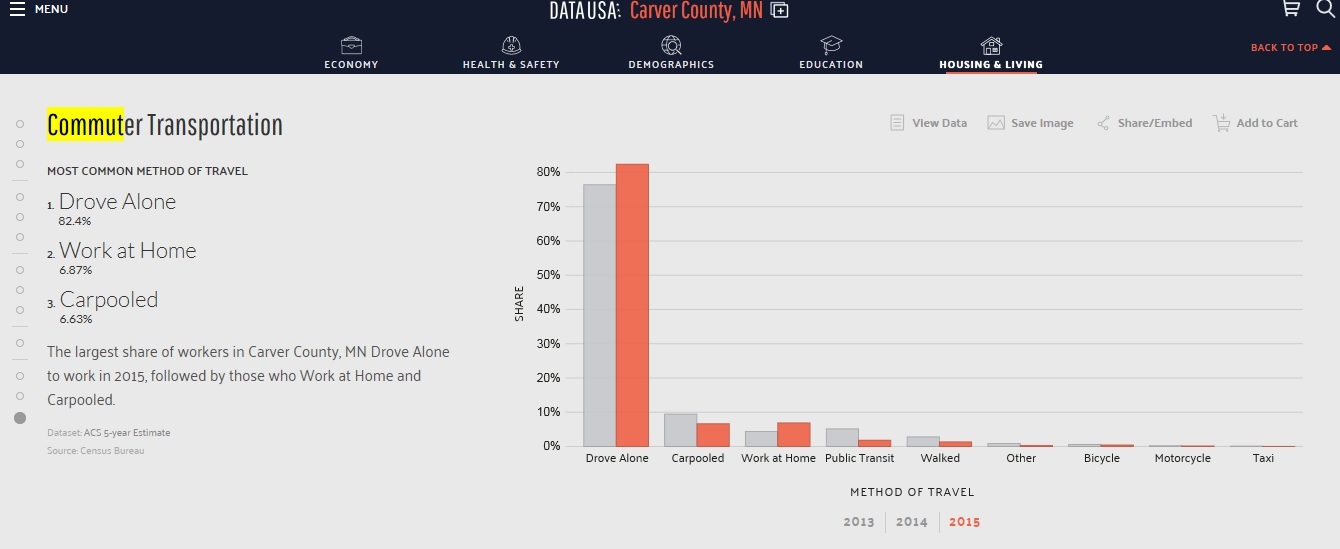EDEN PRAIRIE, Minn. – Travel the less than ten mile stretch of Highway 212 between Eden Prairie, through Chanhassen and into Chaska, you will find three SouthWest Transit Bus Park and Ride garages along the highway. Approximately two miles North of Highway 212 is another four story SouthWest Transit garage in Chanhassen.
Over $46 million dollars was spent on these four garages since 1998. While the five-story garage in Eden Prairie is filled to capacity during the workweek, the three other garages sit with half of their parking spaces empty. Of the $46 million spent on these facilities, $12.4 million was from the Metropolitan Council and $23.4 million was contributed by the federal government.
Few Commuters to Fill Spaces
Data from the Minnesota Department of Employment and Economic Development (DEED) indicates the majority of workers who commute into the Twin Cities metro live in the region’s seven county area, covering Anoka, Hennepin, Carver, Scott, Dakota, Ramsey and Washington Counties. Chanhassen and Chaska are both in Carver County. DEED combines commuting data for Scott and Carver counties, where only eight percent commuters into the Twin Cities reside.
Data USA, a website that gives demographic information for towns and cities across the nation, shows as of 2015, 82.4% of Carver County commuters drove alone to work, with another 6.87% working from home, while only 1.8% used public transportation.

SouthWest Transit was created in 1986 to provide public transportation to the cities of Chanhassen, Chaska and Eden Prairie when the suburbs opted out of the Metropolitan Transit Commission system, according to its website. The cities created their own bus transit system, SouthWest Transit, under a joint powers agreement.
With many vacant stalls at the Chanhassen and Chaska park and ride facilities, along with low use of public transportation in Carver County, was there really a need to build three substantial park and ride garages so close together?
Travel Sheds
Len Simich, Chief Executive Officer of SouthWest Transit, told Alpha News the reason for the close proximity of the facilities is due to what he calls “travel shed” areas. He said each park and ride lot serves different purposes.
“You have to really look at, and I’ll use the word, “travel shed.” What that is, where are people living and what are their commute patterns. And you have a distinct pattern up along Highway 5 that serves not only the bulk of today’s Chanhassen residents, but also those borders of Minnetonka, Excelsior and Shorewood and then points west, so Victoria, Waconia,” Simich said. “They are aligned across Highway 5. That’s a whole different travel shed than what we have going on down at 212.”
The four-level Chanhassen Transit Station services the Highway 5 travel shed area and was built in 2011 with spaces for over 400 vehicles. The cost to build the station was $8.5 million according to SouthWest Transit.

Simich said that ideally he’d would have prefered the Chanhassen Transit Station, which is tucked behind the Chanhassen Dinner Theater on Market Street, to have been built closer to Highway 5, as there would have been higher visibility and easier access in and out of the garage.
“I’ll be frank, we got the property for nothing, so we put it there,” Simich said.
However, Simich said there are advantages to having the Chanhassen Transit Station located behind the Chanhassen Dinner Theater.
“It serves a dual purpose,” Simich said. “During the day, it is utilized for transit, and in the evening, it will be used more for general public parking. You have the dinner theater and the movie theater and soon you’ll have a lot more development happening around the area, so it’s kind of a multi-use ramp.”
Simich said the close proximity to the heavy rail line was another factor that influenced where the Chanhassen Transit Station would be built.
“Heavy rail and commuter rail, at the time, was an option being pursued and looked at regionally. I think that’s not going to happen, that’s my personal guess, but it was designed and situated where if commuter rail ever did come about, this ramp would actually be used for that purpose as well,” Simich said.
Less than two miles South of the Chanhassen Transit Station sits the SouthWest Village Park and Ride facility off of Highways 212 and 101, with spaces for approximately 500 vehicles. This ramp was built in 2008 for $8.9 million and came about as part of the 212 expansion into Carver and Cologne. Simich explained when 212 was put through, the opportunity came about to place two additional transit stations along the highway in Chanhassen and Chaska.
The East Creek Transit Station in Chaska was constructed in 2013 for $8.7 million and has parking for approximately 600 vehicles. Simich explained SouthWest Transit went through a competitive grant process to fund these facilities through the federal government called the “Congestion Mitigation Air Quality” (CMAQ) grant and a state bond set up just for transit improvements such as major expansions to highways. He said SouthWest Transit also partly contributed to the building of the two park and ride garages along 212.
“We put some of our own money because we did the Eden Prairie project where we put in condos and apartments and about 100,000 square feet of retail, so the dollars we generated there we put back into the stations at 101 and 41,” Simich said.
The total cost of of the three Park and Ride garages in Chanhassen and Chaska totaled $26.3 million.
Station Location Decisions
The decision to locate the Park and Ride facilities so close together was made by SouthWest Transit according to Simich.
“We had a study that we conducted and we looked at where would be the optimum places to put these and what’s the time frame. We are really looking at future projections for Chanhassen, Chaska and points West because while our buses may not go out to Waconia and Cologne, you look at that as part of the travel sheds. You are really building for the future, not just the current time,” Simich said.
Despite SouthWest Transit’s predictions for future population growth, Simich told Alpha News that currently, the further west you go in the SouthWest Transit commuting area, the likelihood of people commuting downtown for work greatly diminishes.
“As you get closer to Eden Prairie, a higher percentage of folks will work downtown than let’s say Chaska and Carver,” Simich said. “That’s why we have to be constantly looking at how our model changes as well.”
SWLRT Impact
Simich said SouthWest Transit is still progressing as if the Southwest Light Rail project (SWLRT) is going to happen.
“I just had negotiation sessions with the Metropolitan Council project office that administers the light rail program because they’re going to come in and take down our station in Eden Prairie and they will be putting in the rail and we’ll have a dual operation.” The Eden Prairie SouthWest Transit bus station was built less than twenty years ago in 1998 at a total cost of $7 million according Simich. “Our operation, while it will change somewhat (with the addition of light rail), our peak operations won’t. But midday, evenings, weekends, we’ll partner and folks will utilize that rail and we’ll have bigger presence with a local connector service. A rail is not going to get you to your final destination,” Simich said.
According to Simich, the SWLRT will be putting in their own platform and parking facilities in Eden Prairie as the SouthWest Transit bus parking at that location is at full capacity. The Eden Prairie station will be the end of the line for the SWLRT.
Looking Ahead
Despite SouthWest Transit’s predictions on population growth in the Chanhassen/Chaska area and beyond, Simich expressed concerns regarding some changes in commuting patterns that are already taking place.
“You have a lot of people, we’re seeing it in Eden Prairie, especially, a lot of people now have home-based offices,” Simich said.
Last year, the Star Tribune reported that Minnesota is a national leader in the telecommuting trend with at least five percent of the state’s 2.8 million workers logged in from a remote location at least part of the time. The Star Tribune reported the growth rate of telecommuting in Minnesota exceeds that of all other commuting categories, including biking, carpooling and public transit.
Because of these changes, Simich said SouthWest Transit has been introducing different services to address the changing needs of its customers that ironically will reduce the need for park and ride facilities.
“An area growing the fastest for us is the service we call PRIME, where it’s an Uber approach to providing community service, so it’s only by demand,” Simich said. “Generally our time frames are within 15 minutes. We’re picking you up and bringing you to a destination and is only right now available within our communities.”
Simich said it has no plans to further expand its service and is at their maximum in what they can do.
“Right now, Chaska is the end of the line for us. In the region, they have this thing called the transit taxing district. As you go beyond Chaska, that transit taxing district is not in place, so those communities would have to, in a sense, opt into this transit taxing district before we can start going out to providing services to them,” Simich said. “That’s why we’re not out in the Victorias or the Waconias, Cologne’s and so forth and those people have to come our way. And that’s all being looked at as well. That’s more of a Met Council regional thing, not so much SouthWest Transit. We are really an operator, not the big policy maker. That all still happens at the Met Council.”
Without plans to further expand service beyond Chaska, with telecommuting on the rise and a low percentage of commuters traveling into the cities from suburbs beyond Hennepin County, and the uncertain arrival of light rail, the question remains if SouthWest Transit will be able to fill vacant parking spots at their multi-million dollar park and ride facilities now or in the future.













